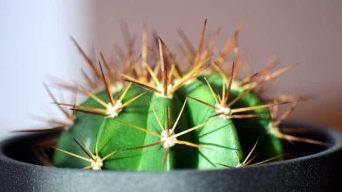Do you have a cactus plant? If so, how much light does it need to grow?
Cactus plants come from the desert, thriving in hot, sunny conditions.
If you are trying to grow a cactus plant indoors, you will need to provide it with plenty of light.
In this article, we will discuss how much light does a cactus need and how to provide it with the right amount of sunlight.
How Much Light Does a Cactus Need?
Most cactus plants are native to the desert, where they thrive in hot, sunny conditions. To grow a cactus plant indoors, you will need to provide it with plenty of light.
The amount of sunlight a cactus needs depends on the type of cactus plant.
Some cactus plants only need four hours of direct sunlight each day, while others require up to eight hours of direct sunlight.
If your cactus plant is not getting enough sunlight, it will start to stretch and become leggy.
To avoid this, make sure to provide your cactus plant with the right amount of sunlight. How much light does a cactus need?
The answer depends on the type of cactus plant!
Desert cacti, like the saguaro cactus, need full sun to grow and thrive. They need at least six hours of direct sunlight each day and can even tolerate up to eight hours of direct sunlight.
If you are growing a desert cactus indoors, make sure to place it in a south-facing window.
If you live in a climate that does not get much sunlight, you may need to supplement your cactus plant with artificial light.
Other types of cactus plants, like the tropical cactus, do not need as much sunlight.
They only require at least four hours of sunlight each day.
A place with indirect sunlight, like an east- or west-facing window, would be ideal for these types of cactus plants.
No matter what type of cactus plant you have, it is essential to provide it with the right amount of sunlight.
Too much or too little sunlight can damage your cactus plant.
In general, all cacti plants need bright light without intense light with at least 3,000 lux.
You can provide your cactus with the right amount of light by placing it in a south- or west-facing window. I
f you live in a climate that does not get much sunlight, you may need to supplement your cactus plant with artificial light.
Providing your cactus plant with the right amount of light is key to keeping it healthy and happy!
Do Cacti Need Direct or Indirect Sunlight?
Most cactus plants need at least four hours of direct sunlight each day. However, some types of cacti need bright indirect light.
Cacti that need direct sunlight include the Saguaro cactus, the Peruvian Apple cactus, and the Golden Barrel cactus.
This type of cactus will not tolerate indirect sunlight and will need to be placed in a location where it can receive direct sunlight for at least four hours each day.
Cactus plants have developed spines and other defenses to protect them from the intense sunlight.
Cacti that need bright indirect sunlight include the Christmas cactus, the Scarlet Ball cactus, and the Zebra cactus.
This type of cactus will tolerate some direct sun but will grow best if placed in a location where it receives only filtered sunlight or indirect sunlight.
Indirect sunlight is sunlight that is not direct. It is the type of sunlight that comes through a window or is reflected off a surface.
Both types of cacti, those that need direct sunlight and those that need indirect sunlight, will do best if they are placed in a location where they receive some morning sun and some afternoon sun.
This will help them to get the most light possible.
When choosing a location for your cactus, make sure to take into account the amount of sunlight that the plant will need.
This will ensure that your cactus gets the proper amount of light and will grow healthy and strong.
How Much Light Does an Indoor Cactus Need?
If you are growing a cactus indoors, it is essential to place it in a location where it will receive the right amount of sunlight.
Most cacti plants need at least four hours of direct sunlight each day, but some may need more or less depending on the type of cactus plant.
No matter what type of cactus plant you have, it is essential to provide it with the right amount of light. Too much or too little sunlight can damage your cactus plant.
Spiny cacti, such as the Hedgehog cactus, need full sun to partial shade. The amount of sunlight these plants need will depend on the climate they are growing in.
If you live in an area with hot summers, your spiny cactus will need more shade than if you live in an area with cooler summers.
Cacti native to the desert, such as the Saguaro cactus, need full sun all day long. These plants cannot tolerate shady conditions.
Cactus plants with small or just a few spines, such as the prickly pear cactus, need partial shade. These plants cannot tolerate full sun all day long because it will cause the leaves to scorch.
They need bright but indirect sunlight, such as that found in an east- or west-facing window.
This type of cacti also does not like hot temperatures, so it is best to place it in a room that does not get too hot.
In general, desert cacti need more sunlight than cacti native to other climates. They need to be in direct sun for at least six hours a day to stay healthy.
When growing desert cactus plants indoors, it is important to place them in a south-facing window where they will get the most sunlight.
In the case of tropical cacti, such as the Christmas cactus, these plants need bright but indirect sunlight.
They should be placed in an east- or west-facing window to receive some direct sunlight each day but not too much.
Tropical cacti also need to be in a room that is warm but not too hot. These plants do not like it when the temperature gets below 60 degrees Fahrenheit.
Can Cactus Live With Artificial Light?
Cacti can live with artificial light, but it is not the best solution for them.
Artificial light does not provide the plant with the correct type of light it needs to thrive, and because it delivers less energy than natural light, your plants will require more hours of exposure.
Cactus plants may need 16 hours of artificial light each day to thrive.
It is best to place your cactus in a location where it will receive the most natural light possible.
If you must use artificial light, use fluorescent bulbs or LED grow lights. Don’t use mercury vapor or incandescent bulbs, as they produce too much heat and will not give your cactus the light it needs.
Artificial light can be used as a temporary solution when you cannot place your cactus in a sunny spot.
If you need to move your cactus plant, do it gradually over a week so that the plant can get used to the new light conditions.
Cacti grown under artificial light will not grow as fast or as big as cacti grown under natural light.
How Much Light Does an Outdoor Cactus Need?
Outdoor cactus plants need at least six hours of direct sunlight each day to stay healthy.
They can tolerate partial shade, but they will not grow as well in shady conditions.
If you live in an area with hot summers, your cactus will need more shade than if you live in an area with cooler summers.
In general, desert cacti need more sunlight than cacti native to other climates. They need to be in direct sunlight for at least six hours a day to stay healthy.
When growing desert cactus plants outdoors, it is important to place them where they will receive the most sunlight.
Cacti native to other climates, it is best to place your cactus in a sunny spot that will get some morning sun but be in the shade during the hottest part of the day.
Although cactus plants can tolerate direct sunlight, too much sun can cause the cactus to sunburn, especially during the summer.
If you live in an area with high temperatures, providing your cactus plant with some shade during the hottest part of the day is best.
Can I Move My Cactus Indoors If It’s Too Sunny Outside?
Yes, you can move your cactus indoors if it is too sunny outside, but you need to do it gradually.
Cactus plants are very sensitive to changes in light, and sudden changes can cause the plant to go into shock.
To avoid this, you should slowly move your cactus plant from its sunny spot outdoors to a shadier place indoors over the course of a week.
This will give the plant time to get used to the new light conditions.
You should also keep in mind that cacti grown under artificial light will not grow as fast or as big as cacti grown under natural light.
Therefore, it is best to temporarily move your cactus indoors if it is too sunny outside. Once the weather cools down, you can move your plant back outside.
How Much Light Does a Cactus Need in Winter?
Cactus plants do not need as much light in winter as in summer. Most cacti go dormant in winter, and they do not need as much light to stay alive.
In general, cacti only need about four hours of direct sunlight each day during the winter. But is best to provide as much light as possible to prevent your cactus from going into shock.
During the winter, you should place your cactus in a sunny spot that gets some morning sun but is in the shade during the afternoon. This will give your cactus the light it needs without exposing it to too much heat.
If you live in a cold climate, your cactus may need to be indoors during the winter months.
You can place your cactus in a sunny spot near a window where it will get at least four hours of direct sunlight each day and be protected from the cold weather.
Can Cacti Grow in the Shade or Low Light?
While cacti are typically known for being desert plants that love lots of sun, there are many varieties that can thrive in shady or low-light conditions.
If you’re interested in growing cacti but don’t have a sunny spot in your home, don’t despair!
These hardy plants can still flourish indoors as long as you give them the correct type of care.
Som low light cactus plants are:
- Scarlet Ball Cactus (Parodia haselbergii)
- Crown Cactus (Rebutia)
- Zebra Cactus (Haworthia attenuata)
- Christmas Cactus (Schlumbergera bridgesii)
- Hurricane Cactus (Lepismium cruciforme)
Cacti that grow in shady or low-light conditions need less sun exposure than those that require full sun.
In general, they should receive at least four hours of direct light per day, but it’s also essential to make sure they’re getting some indirect light as well.
This can be achieved by placing them near an east- or west-facing window.
If you don’t have a spot in your home that gets enough light, you can also grow cacti under artificial lighting.
Fluorescent bulbs are a good option for this, as they emit little heat and provide the right type of light for these plants to thrive.
Place the cacti within two to four feet of the bulbs, and make sure they’re turned on for at least eight hours per day.
Cacti grown in shady or low-light conditions may not grow as large or produce as many blooms as those that get more sun, but with a little bit of extra care, they can still be healthy and thriving plants.
So if you’re looking to add a cactus to your indoor jungle, don’t let a lack of sunlight stop you!
There are plenty of varieties that will do just fine in lower light conditions.
How To Tell if a Cactus Needs More Light?
Light is an essential part of a cactus’s growth and development.
Not only does light provide energy for the plant to grow, but it also helps to regulate vital processes like photosynthesis and respiration.
There are a few signs that your cactus may need more light:
- The cactus is stretched out or etiolated. This means it is growing taller and thinner in an attempt to reach the light
- The cactus grows more on one side than the other
- The cactus is losing its color and turning pale
- There are no new spines or buds appearing
- The cactus is producing fewer blooms than usual
- The cactus leaves are yellowing or falling off
- The cactus is overall just looking unhealthy
Try moving your cactus to a brighter spot if you notice any of these signs.
You may need to experiment a bit to find the perfect location, but your cactus will thank you for it!
How To Tell if a Cactus Is Getting Too Much Sunlight?
If you think your cactus is receiving too much sunlight, there are a few things to look out for.
The most common signs of a sunburned cactus are:
- The cactus has black or brown patches on its skin.
- The cactus’ leaves are wilting or turning yellow.
- The cactus is dry and crumbly to the touch.
- The cactus is dehydrated, and its stems and leaves are shriveled.
If you see any of these signs, it’s important to take action immediately. Move your cactus to a shadier spot.
Sun damage is not always immediately visible. If you suspect your cactus has been sunburned, check the roots.
If they are dried out or shrunken, this is a sign that the plant is not getting enough water. Over time, sun damage can kill a cactus.
To prevent sun damage, make sure to introduce your cactus to sunlight gradually.
Start by placing it in an area with indirect sunlight and slowly moving it to a sunnier spot over a few weeks.
If you live in a hot climate, make sure to put your cactus in a spot where it will get some afternoon shade.
By following these tips, you can ensure your cactus gets the sunlight it needs without getting sunburned.
Final Thoughts
Cacti need sunlight to grow and thrive. However, too much sun can be damaging.
When deciding how much light your cactus needs, it is important to consider the type of cactus, the climate you live in, and the time of year.
By paying attention to your cactus’s appearance and monitoring its growth, you can make sure it is getting the perfect amount of light.







